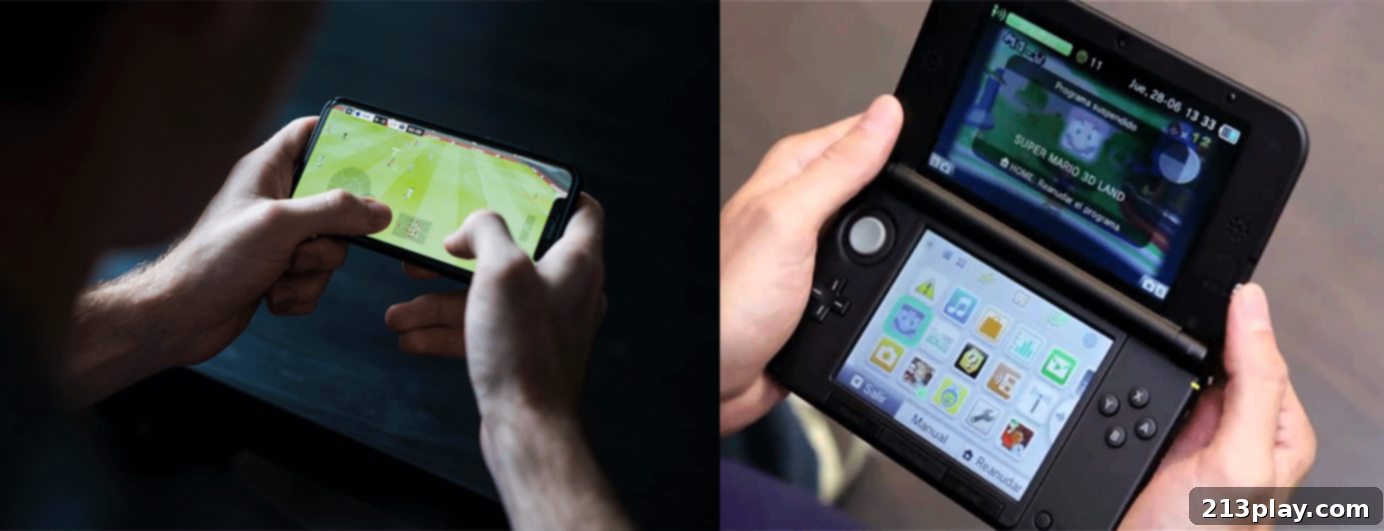The Evolving Gaming Landscape: How Smartphones and Streaming are Redefining Consoles
Table of Contents
Smartphones vs. Traditional Consoles: A Shifting Paradigm
Welcome back, readers! After a brief hiatus, we’re excited to dive into a compelling topic that has been shaping the entertainment landscape: the evolving relationship between smartphones and game consoles. Like many enthusiasts, my personal gaming journey began in the vibrant, noisy halls of local arcades, eventually transitioning to portable adventures on a Game Boy Advance, then delving into the expansive worlds of PC gaming. Today, my primary gaming device, for convenience and capability, has become my smartphone.
Over the past few years, the advancements in smartphone technology have been nothing short of astonishing. These pocket-sized powerhouses are steadily transforming into universal devices, capable of tasks once exclusively reserved for high-end personal computers or dedicated gaming rigs. Modern smartphones can now effortlessly run graphically demanding games that were once considered challenging even for many PCs. This rapid technological progression suggests a clear industry trend: the ambition to create a single, all-encompassing device.
The concept of a “universal device” – one that can seamlessly handle work, communication, entertainment, and complex gaming – once seemed far-fetched. Yet, history consistently demonstrates that technological innovation is profoundly driven by market demand. As the adage goes, “If the buyer is willing to pay for it, manufacturers are willing to work for it.” This principle perfectly encapsulates the smartphone industry’s trajectory. Smartphones have already largely supplanted standalone music players and dedicated GPS devices, and they are making significant inroads into the functions of personal computers. If this trend continues, a smartphone could indeed become the singular device for all digital needs. But what implications does this have for traditional game consoles, particularly the handheld variety?
Will Smartphones Displace Dedicated Game Consoles?

While a definitive “yes” or “no” remains elusive, our current analysis points towards a more nuanced outcome than a simple takeover. We anticipate a significant merger or integration between these two seemingly disparate industries. In this future, smartphones are likely to emerge as the dominant central device, while traditional console manufacturers adapt by producing compact, specialized accessories designed to enhance the smartphone gaming experience. This strategic shift could allow console brands to maintain relevance and innovate within a rapidly changing market.
Why would established console companies embrace such a model? The answer largely lies in economic efficiency and consumer convenience. By leveraging the existing smartphone ecosystem, console manufacturers can significantly reduce production costs. They eliminate the need to design, manufacture, and market screens and core computing hardware for handheld devices, as these components are already present in every smartphone. This approach allows them to focus resources on game development and optimizing the gaming experience through high-quality peripherals.
This convergence is not merely theoretical; it’s already unfolding. Consider the “Razer Kishi” and “Backbone One” controller series, both designed specifically to transform smartphones into portable gaming consoles. These accessories mirror the ergonomic design of traditional handhelds, providing tactile controls that vastly improve mobile gameplay. Furthermore, major players like Xbox have launched sophisticated cloud gaming services such as “Xbox Game Pass.” This service allows subscribers to stream a vast library of AAA titles directly to their smartphones, tablets, or PCs for a monthly fee. This model not only offers unparalleled access to games but also provides developers with a robust platform that offers some protection against piracy.
The beauty of this model is that it negates the need for an expensive, dedicated gaming computer or a console. Users can simply download an app, register, subscribe, and begin playing high-fidelity games on their existing smartphones. The only additional investment is a smartphone controller attachment, typically costing around $100. For companies like Xbox and other console developers, this represents a brilliant strategy: they can simultaneously generate revenue from subscriptions and accessory sales while saving on hardware manufacturing. Moreover, this ecosystem strengthens their control over content distribution, potentially incentivizing game developers to keep their flagship titles within these integrated platforms.
The Future Trajectory of Game Developers

The journey of game developers on the smartphone platform has been a fascinating evolution. In the early days of smartphones, many developers experimented with porting their existing console or PC titles. Often, these attempts yielded mixed results. One early success was “Sonic Adventure,” an older 2D Sega title that, due to its simpler graphics and limited control requirements, translated well to touchscreens, much like today’s popular endless runners such as Subway Surfers or Temple Run. However, resource-heavy 3D games of the era struggled on the nascent smartphone hardware.
Capcom, for instance, released a significantly “toned-down” version of their acclaimed horror title, “Resident Evil 4,” on smartphones. The mobile adaptation featured substantially reduced graphics, less intricate character models, and simplified textures compared to its PC and console counterparts. Similarly, “Devil May Cry 4” faced identical compromises, leading to an experience that often fell short of player expectations for a flagship franchise. The limitations of early smartphone processors, smaller RAM capacities, and restrictive touch controls made faithful ports incredibly challenging.
However, developers quickly recognized the immense potential and profitability of the smartphone platform. Rather than continuing to compromise high-quality console games, they began creating entirely new titles specifically optimized for mobile devices. These mobile-native games were designed from the ground up to leverage touchscreen interfaces and fit within the performance envelopes of smartphones, without sacrificing the core gameplay experience. Examples include critically acclaimed 2D titles like “Rayman Jungle Run,” “Burnout Crash,” and even the unique “Grand Theft Auto: Chinatown Wars,” which offered a distinct top-down perspective perfectly suited for mobile.
For a period, the console and mobile gaming industries largely diverged, with developers creating distinct types of games for each platform. Yet, with the relentless increase in smartphone processing power and the advent of high-speed mobile internet like 5G, these two worlds are once again converging. The design of modern smartphone gaming accessories, such as the Xbox Razer series and the Backbone One, clearly draws inspiration from hybrid consoles like the Nintendo Switch, bridging the gap between mobile convenience and console-like control.
Beyond hardware, the business models are also merging. Xbox, for instance, has taken cues from streaming giants like Netflix for its Game Pass service. By hosting games on powerful cloud servers equipped with high-end graphics cards, processors, ample RAM, and SSD storage, Xbox allows users to stream demanding titles directly to their smartphones. This high-cost, yet ingenious, infrastructure ensures that even with limited local device specifications, smartphones can deliver a premium gaming experience. This revolutionary approach eliminates the need for players to own powerful hardware, democratizing access to cutting-edge games.
Considering this historical progression, it’s evident that the traditional supply chain for game developers is undergoing a radical transformation. While developers will continue to create visually stunning and computationally intensive games, the primary distribution model is shifting. Instead of selling physical copies or direct digital downloads to consumers, games are increasingly hosted on subscription-based streaming services like Google Stadia (though now defunct, it pioneered the concept) and Xbox Game Pass. In essence, the gaming industry is transitioning from a product-centric model to a service-provider model, where powerful tech corporations like Google, Sony, and Xbox establish themselves as the controlling intermediaries between developers and players.
Gaming Smartphones Versus Handheld Consoles: A Symbiotic Evolution

Contrary to an outright “takeover,” the smartphone industry isn’t poised to eliminate traditional game consoles. Instead, console companies are demonstrating remarkable adaptability, responding to evolving consumer behaviors. The growing preference for gaming on the go, combined with the widespread deployment of 5G networks, has made streaming high-performance games on mobile devices not only possible but highly practical. These technological advancements are collectively driving a profound, revolutionary change across the entire gaming industry.
This new era heralds a consumer model where individuals primarily invest in one high-end, versatile smartphone and then subscribe to multiple gaming services. This approach offers unparalleled flexibility and access to a vast library of games without the upfront cost of dedicated console hardware. For game developers, this shift liberates them from the complexities and expenses associated with physical game distribution and global logistics. They can now focus almost entirely on the creative process of developing engaging games, knowing that powerful online platforms will handle the delivery.
However, this convenience comes with a significant reallocation of power. Mega-corporations, operating these streaming platforms and ecosystems, gain even greater control, not only over the consumer’s gaming choices and spending habits but also over game developers themselves. Developers become reliant on these platforms for reach and monetization, influencing everything from game design to revenue sharing models. This dynamic centralizes power in the hands of a few dominant players.
Ultimately, these profound changes reduce the necessity for most consumers to own dedicated gaming consoles. While casual and even serious gamers can enjoy a premium experience through their smartphones and cloud services, traditional consoles may become niche products. They will likely cater to a smaller, yet passionate, segment of “die-hard fans” who prioritize specific hardware advantages, local ownership of games, or unique console-exclusive experiences. This process also has environmental implications: by reducing the manufacturing of separate gaming hardware, resources can be conserved, and any remaining dedicated consoles can be engineered for even higher performance and premium quality, serving their dedicated fanbase with distinction.
Concluding Thoughts on the Gaming Revolution
The seismic shifts occurring in the gaming industry are creating an exciting new ecosystem where access to high-quality games is more affordable and convenient than ever before. For a relatively small subscription fee, players can dive into extensive libraries of titles on the device they already carry everywhere. This model empowers game developers to concentrate on innovation and creating richer gaming experiences, unburdened by the traditional challenges of global distribution and hardware compatibility.
However, like any significant technological and business model change, this era of convenience is not without its potential consequences. The widespread adoption of the Software-as-a-Service (SaaS) business model in gaming introduces new challenges. Issues such as dependence on stable internet connections, the longevity and reliability of streaming services, questions of game ownership versus access, and potential data privacy concerns will undoubtedly emerge as the industry matures. There is no universally perfect strategy, and only through continuous observation of industry trends and consumer feedback will the true long-term impact of this gaming revolution become clear.
We sincerely hope you found this exploration of smartphones versus consoles insightful and thought-provoking. This analysis draws upon current real-time changes and emerging trends within the dynamic gaming industry. For more captivating articles on technological advancements and industry news, we invite you to explore our global tech news section. Additionally, if you’re interested in detailed critiques and recommendations, please check out our comprehensive game and app reviews.
